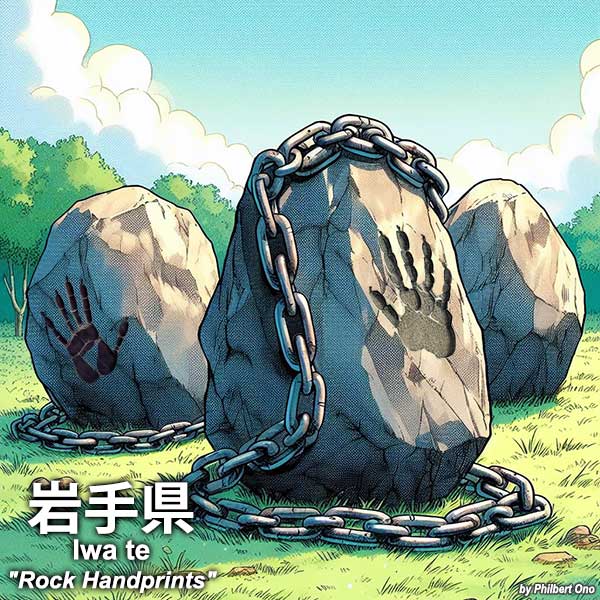IWATE – Rock Handprints 岩手県

Prefectural name Iwate comes from a local legend. The legend’s setting is Mitsuishi Shrine (三ツ石神社) in Morioka, dedicated to three granite boulders embodying a god named Mitsuishi (Three Rocks). A supernatural, evil being (or demon) called Rasetsu (羅刹鬼) was wreaking havoc on local residents and travelers.
The people turned to the god Mitsuishi to punish Rasetsu. Mitsuishi listened to their pleas and went to catch and chain Rasetsu to the three granite boulders at the shrine.
Rasetsu, shackled and immobile, surrendered and promised not to ever disturb the people again and never to return to this place. As proof of his promise, he made handprints (notice the claws too) on the boulders, then ran away to Mt. Nansho (南昌山), leaving Morioka for good.
The rock handprints became the origin of the name “Iwate” (literally “Rock Hand”). It also gave rise to the place name of “Kozukata” (不来方) meaning “Never to Return.” Kozukata was later renamed Morigaoka and then Morioka, now the capital of Iwate Prefecture.
Not only that, the local people were so overjoyed with the banishment of Rasetsu that they danced around the three Mitsuishi granite boulders while singing “Sa-sa odore.” This became the famous Sansa Odori dance held every summer in Morioka as one of the Big Four Summer Festivals in the Tohoku Region (other three are Sendai Tanabata, Aomori Nebuta/Neputa, and Akita Kanto Matsuri).
Mitsuishi Shrine still has three boulders and two demon handprints on a separate surface. Although there’s a legend saying that the three boulders fell here from an eruption of Mt. Iwate, scientists say that the three boulders were not from an eruption and were originally already here.
Another legend says that when Mt. Iwate erupted with explosive force, the volcanic rocks spewing out were called “iwaide” (岩出) or “rocks spewing.” The pronunciation later dropped the “i” and morphed into “Iwate” (岩手), the current kanji characters.
Since the prefectural capital was located in the Iwate district of Morioka, the prefecture was so named.
Map to Mitsuishi Shrine and the three boulders (near Kami-Morioka Station (JR Yamada Line):
Old province name: Rikuchu-no-Kuni (陸中国), separated from Mutsu-no-Kuni (陸奥国).
*The AI-generated image is for illustrative purposes only and may not accurately depict any particular place in the prefecture.
*Major reference sources: Official prefectural website, Japanese Wikipedia, other websites.
Origin of other prefectural names (etymologies)
Overview | Aichi | Akita | Aomori | Chiba | Ehime | Fukui | Fukuoka | Fukushima | Gifu | Gunma | Hiroshima | Hokkaido | Hyogo | Ibaraki | Ishikawa | Iwate | Kagawa | Kagoshima | Kanagawa | Kochi | Kumamoto | Kyoto | Mie | Miyagi | Miyazaki | Nagano | Nagasaki | Nara | Niigata | Oita | Okayama | Okinawa | Osaka | Saga | Saitama | Shiga | Shimane | Shizuoka | Tochigi | Tokushima | Tokyo | Tottori | Toyama | Wakayama | Yamagata | Yamaguchi | Yamanashi